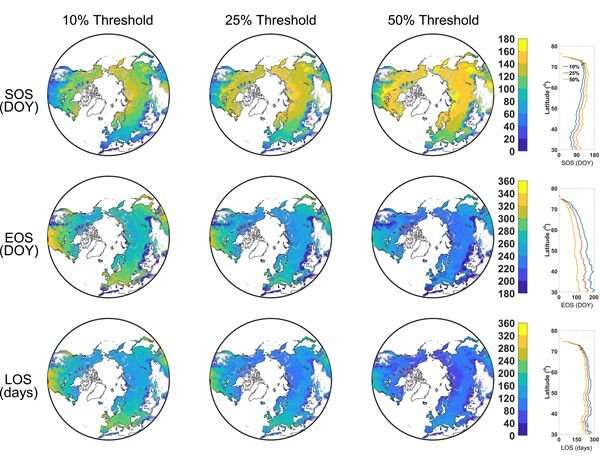This article has been reviewed according to Science X's editorial process and policies. Editors have highlighted the following attributes while ensuring the content's credibility:
fact-checked
peer-reviewed publication
trusted source
proofread
New vegetation photosynthetic phenology dataset generated in northern terrestrial ecosystems

Vegetation phenology, the cycle sequence of the vital activities, is a highly sensitive indicator of the climate impacts on terrestrial ecosystems. Most recent studies focus on the structural changes in plants, such as using the growth process of leaves represented by the greenness indicators. However, these indices work well for capturing the variations in chlorophyll content or structural changes but are less sensitive to physiological changes in vegetation photosynthesis.
Researchers from the Wuhan Botanical Garden of the Chinese Academy of Sciences developed a method combining a smoothing filter and change-point detection to retrieve photosynthetic phenology from a recently developed satellite-based solar-induced chlorophyll fluorescence (SIF)-based gross primary productivity (GPP) product (GOSIF-GPP: 2001–2020) with a 0.05° spatial resolution. This study, published in Scientific Data, is titled "Vegetation photosynthetic phenology dataset in northern terrestrial ecosystems."
Several phenological metrics were considered, including the state-transition dates of photosynthesis (SOS), the end state-transition dates of photosynthesis (EOS), and the duration length of photosynthesis for terrestrial ecosystems above 30° N latitude (northern biomes, including forests, shrublands, savannas, grasslands, wetlands and croplands).
The dataset includes single-season and double-growing season phenology time, and the corresponding thresholds extracted at 10%, 25% and 50%. Each data is compared to other vegetation indices or GPP data and validated using the flux dataset.
This phenology product allows us to capture multiple photosynthetic activities of vegetation and helps to monitor the impact of climate change on terrestrial ecosystems.
More information: Jing Fang et al, Vegetation photosynthetic phenology dataset in northern terrestrial ecosystems, Scientific Data (2023). DOI: 10.1038/s41597-023-02224-w
Journal information: Scientific Data
Provided by Chinese Academy of Sciences





















